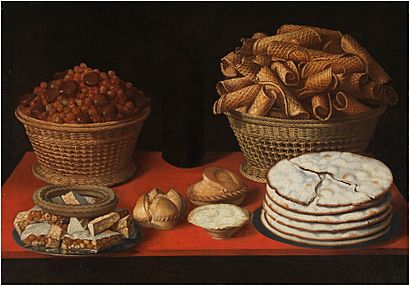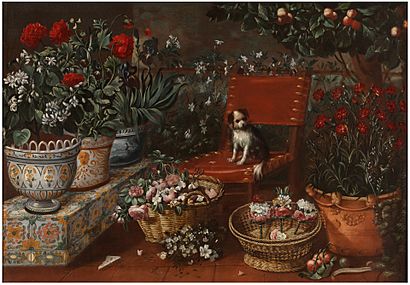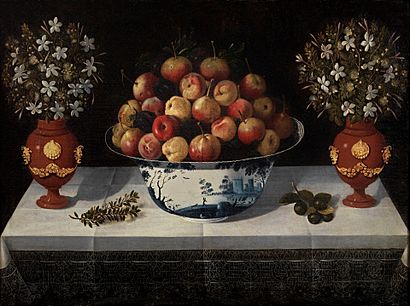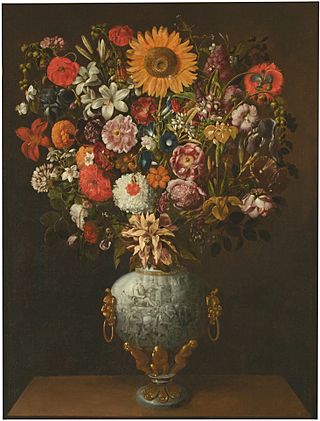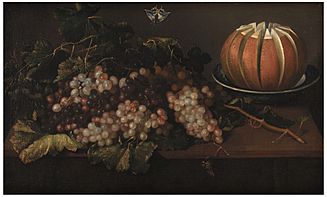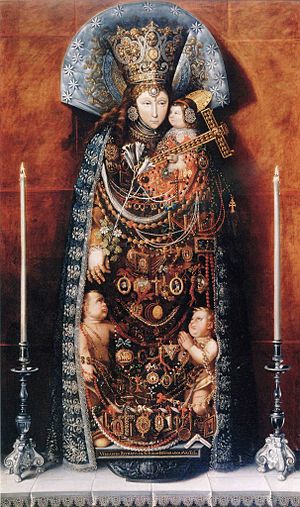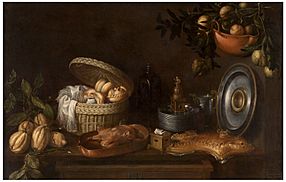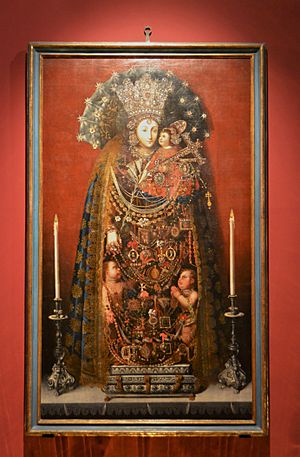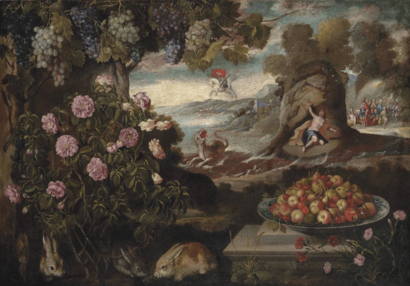Tomás Yepes facts for kids
Quick facts for kids
Tomás Yepes
|
|
|---|---|
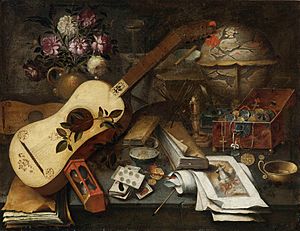
Still Life with a Guitar by Yepes, c. 1650
|
|
| Born | 1595 or 1600 |
| Died | 16 June 1674 (aged 78–79 or 73–74) Valencia, Spain
|
| Resting place | Church of San Esteban |
| Nationality | Spanish |
| Movement | Bodegón, Baroque |
Tomás de Yepes (also known as Thomas de Yepes) was a Spanish painter who lived from around 1595 or 1600 to 1674. He worked in the Kingdom of Valencia, which is now part of Spain. Yepes was part of the Baroque art movement. He was famous for painting still life pictures, especially those showing food and everyday objects. These types of paintings are called bodegón in Spanish.
Yepes created paintings for both private buyers and public events. He started painting in the early 1600s, but most of his known works were made after 1642. He continued to paint until he died. His paintings of flowers, fruits, and common items were very popular in his region during the 1600s and 1700s. He is especially known for his unique way of painting flowers. You can find his artworks in museums and private collections around the world. The Museo del Prado in Madrid has the largest collection of his paintings.
Contents
Life of Tomás Yepes
Tomás Yepes was born to Pascual Tomás Yepes and Vicenta Pujades. He was born either in 1595 or 1600. We don't know for sure if he was born in the city of Valencia, but he was active there during his career. He is considered to have been born in the Kingdom of Valencia.
Not much is known about Yepes' personal life, but we know about his art career. In October 1616, he joined the Colegio de Pintores de Valencia, which was a school for painters. By 1630, he was selling his paintings at fairs in Medina del Campo.
Yepes had an older sister named Vicenta, who owned a candy shop. In 1631, she asked him to pay back some old debts. Yepes settled these debts by giving her some religious paintings.
Yepes was married to Ana Eres, who came from a rich family in Valencia. Her family owned properties that they rented out. After her brothers died, Ana Eres became the only heir to her family's wealth in 1635. Yepes' father-in-law, Gaspar Eres, was a carpenter. In 1635, Yepes and Gaspar Eres together received money from Medina del Campo.
Yepes also painted for specific customers. In 1632, he sold some fruit paintings to a notary named Vicente Cortés. In 1633, he made a deal with a merchant, Juan Ruiz, to get fabric and cloth for his paintings. In 1638, he delivered eight paintings to Simón Colomer, fulfilling an order from the previous year.
Even though Yepes started painting in the early 1600s, most of his known works were created after 1642. In 1655, his paintings were shown at the Convent of Santo Domingo. This was during a celebration for Saint Vincent Ferrer. Yepes was well-known for painting flower vases and fruits.
Like another painter, Francisco Pérez Sierra, Yepes grew different kinds of flowers in his own garden. He used these flowers as models for his paintings. He continued to paint throughout the 1660s. His signed paintings have dates up to the year he died. Yepes passed away in Valencia on June 16, 1674. He was buried at the Church of San Esteban.
Themes in Yepes' Art
Yepes was a master of bodegón and still life paintings. He used techniques like chiaroscuro (strong contrasts between light and dark) and tenebrism (using very dark areas to make bright areas stand out). His paintings show great detail and deep colors, which are typical of the Spanish Baroque style. He often painted realistic scenes, but he also included items that showed the good things in life in Valencia. This was different from other Spanish Baroque painters who often focused on simpler, more serious themes.
Yepes is mostly known for painting flowers, fruits, and everyday objects placed on tables or in outdoor settings. Many of his paintings share special features:
- Flowers in fancy vases or ceramic pots.
- Fruits in shiny or porcelain bowls. Sometimes these bowls even had landscapes painted on them!
- Plain or decorated tablecloths, sometimes with lace.
His works often have balanced, symmetrical designs. They usually have soft, dim lighting and a wide range of colors. His early paintings showed a lot of tiny details. Later in his life, his style became smoother and more free.
Yepes painted flowers throughout his life. He painted them alone or as part of bigger scenes. His flower vases and pots are considered very unique and different from other still life painters of his time. For example, in Vase with Quadriga Profile View (1643), he painted 26 different kinds of flowers against a dark background. The vase and tablecloth were plain to make the colorful flowers stand out. In another painting, Vase with Chariot seen from the Front (1643), he painted flowers spread out in the vase. This allowed viewers to focus on each individual flower and its perfect shape.
Yepes studied the works of Juan van der Hamen. Some of Yepes' early paintings looked similar to Hamen's style. Both artists used balanced designs, dark lighting, and made objects look very real by showing their outlines and using many layers of paint. Yepes' paintings of sweets and desserts, like Sweets and Nuts on a Table, are similar to Hamen's works. They both used strong light and shadow and balanced designs. Later, Yepes' paintings became more varied. He started including different items like Manises ceramics, Delft porcelain vases, rich rugs, and landscapes.
Yepes was also famous for how he painted grapes. He painted them in three main ways:
- By themselves, focusing only on the grapes, like in Still Life of Grapes (1649).
- As part of a larger still life scene, like in Still Life with Grapes (1655).
- As a small part of a bigger scene or different theme, like in Landscape with a Vine (1645).
His grape paintings were similar to those by other famous artists. One writer, Marcos Antonio Orellana, praised Yepes' grapes. He said they looked so real they could trick birds, just like the famous grapes painted by the ancient Greek artist Zeuxis.
Virgin of the Forsaken (1644) is a religious work by Yepes. It uses a style called horror vacui, which means "fear of empty space," so the painting is very full. It's also a trompe-l'œil, meaning it "fools the eye" into thinking it's real. The painting shows Our Lady of the Forsaken, who is the patron saint of Valencia. She is on an altar surrounded by jewels, rosaries, and small painted pictures.
Yepes also painted in the vanitas style. These paintings remind us that life is short and things don't last forever. In his Vanitas (17th-century), he arranged a skull and a bone with a book, an hourglass, flowers, and a cross. This was to show that everyone dies, but through faith, they can find new life.
You can see the influence of Flemish Baroque painting in some of Yepes' works. For example, Four Pots of Flowers in a Garden (1663–64) is painted in a more natural way, less decorated. He also used ideas from Flemish art in other paintings. In Still Life (1668), he showed oranges and lemons in a basket, along with a roasted bird and a meat pie. This style was similar to art from the Levant region.
Yepes also painted animals and scenes from everyday life. Garden Corner with a Dog (1660s) is an example of his animal paintings. Hunter Drinking in a Stream (1650) and Hunter Asleep in a Landscape (1650) are examples of his everyday scenes. In Still Life of Birds and Hare (1643), he painted dead birds hanging symmetrically, with a plucked chicken in the middle. He also showed sausages and eggs on a table.
One of Yepes' paintings is an allegory called Allegory of the Senses (around 1650). An allegory uses symbols to represent ideas. In this painting:
- A guitar represents sound.
- Flowers represent smell.
- A soup bowl represents taste.
- A document represents sight.
- Jewelry represents touch.
Yepes' Works
The Museo del Prado in Madrid has the largest collection of Yepes' paintings, with more than 15 works. In 2006, seven more of his works were added to the museum from a private collection. These included two of his earliest surviving paintings: Delft Fruit Bowl and Two Vases of Flowers (1642) and Two Fruit Bowls on a Table (1642). Other paintings like Still Life of Birds and Hare (1643) and Landscape with a Vine (1645) were also added.
Virgin of the Forsaken (1644) can be found at the Convent of Las Descalzas Reales in Madrid. Another version of this painting, Mother of God of the Forsaken (1640s), is at the Church of St. Thomas and St. Philip Neri. The Museum of Fine Arts of Valencia has works like Still Life with a Ceramic Fruit Bowl (1650), Hunter Drinking in a Stream (1650), and Hunter Asleep in a Landscape (1650).
The Fondation Raus pour le Tiers-Monde in Zurich has two farmyard scenes by Yepes: Turkey, Partridge and Pigeon on a Terrace (1649) and Rooster, Hen and Chicks (1649). Four Pots of Flowers in a Garden (1663–64) is part of the Menil Collection in Houston.
Many of his other paintings are in various museums and private collections around the world.
The "Pseudo-Hiepes" Mystery
For a while, art experts used the name "Pseudo-Hiepes" to describe an unknown artist. This artist had about 40 still life paintings from the second half of the 1600s that were thought to be theirs. Some art historians even thought this artist was Italian because their paintings used shadows in a way similar to the Italian painter Caravaggio.
The name "Pseudo-Hiepes" was used because one of these paintings had "Hiepes" written on it. For a long time, people thought this painting was by Tomás Yepes. However, an art historian named William B. Jordan looked closely at the painting. He realized that all of Yepes' real signatures were much larger and used capital letters. He believed the "Hiepes" on this painting was added much later, probably in the 1800s, and was not Yepes' true signature.
Jordan noticed that both Yepes and the "Pseudo-Hiepes" artist used old-fashioned styles for their time. They both used dark backgrounds to make colors stand out. They also used strong light coming from the left, which created shadows behind objects. Their paintings always had a balanced and symmetrical look. Because of these similarities, it was easy for people to mistakenly think the "Pseudo-Hiepes" paintings were by Yepes.
In 2009, a signed still life painting by an artist named Bernardo Polo was found. This painting looked almost exactly like the works of "Pseudo-Hiepes." This discovery proved that Bernardo Polo was actually the artist previously known as "Pseudo-Hiepes."
Yepes' Legacy
Tomás Yepes was a very important painter in Valencia during his lifetime. He remained a well-known artist in the region throughout the 1600s and 1700s. He is considered the most important bodegón painter of the Baroque period in Valencia.
A Spanish writer named Marco Antonio Ortí wrote in 1655 that Yepes had "gained a very unique reputation and credit" in the kingdom. William B. Jordan described Yepes' works as "full of an irresistible charm and delightful creativity." He said they suggested the rich and enjoyable life of Valencia, which was a busy port city. Even though he was famous locally, Yepes was not mentioned in a nationwide book about artists until 1800. This was when Juan Agustín Ceán Bermúdez published his dictionary of famous Spanish artists.
In 1995, art historians organized a special exhibition of Yepes' works in Valencia. This exhibition helped people learn more about his life and paintings. A reviewer said that Yepes was greatly admired in his own time and has been "a major rediscovery of our time." The exhibition showed that Yepes was not only a very skilled painter but also kept his customers interested with his amazing flower paintings and different types of still life art.
See also
 In Spanish: Tomás Yepes para niños
In Spanish: Tomás Yepes para niños


